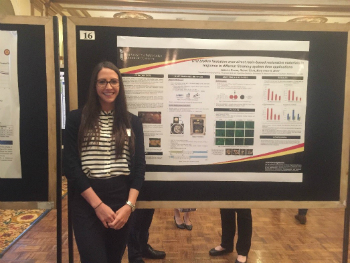 Jessica Kocan, DDS ’18, presented dental research on enhancing composite restorations at the Hinman Student Research Symposium in Memphis, Tenn., on Oct. 28-30. Called Oral Biofilm Formation over Restorative Materials in Response to Different Finishing System Time Applications, her study was conducted during the 2015 Summer Research Training Program at the University of Maryland School of Dentistry (UMSOD).
Jessica Kocan, DDS ’18, presented dental research on enhancing composite restorations at the Hinman Student Research Symposium in Memphis, Tenn., on Oct. 28-30. Called Oral Biofilm Formation over Restorative Materials in Response to Different Finishing System Time Applications, her study was conducted during the 2015 Summer Research Training Program at the University of Maryland School of Dentistry (UMSOD).
The six-week program offers first- and second-year students an opportunity to gain valuable experience by working in the school’s research labs. Each student is assigned a mentor within a specific research department. “Jessica is a very dedicated student and a great team worker,” said Dr. Mary Anne Melo, assistant professor at the UMSOD Operative Dentistry Division, General Dentistry Department, who is Kocan’s mentor. “She’s a rising star.”
At the end of the program, students give poster presentations that are judged by a panel of UMSOD research faculty. The top three students are selected to present their findings at national conferences. “The summer program seemed like the perfect opportunity to get experience because you can focus exclusively on research,” Kocan said.
Growing up in Erie, Penn., Kocan initially planned to attend medical school. But, she said, “when I was thinking of what kind of medicine I wanted to be in, dentistry popped into my head.” She also interned with a pediatric dentist and realized that was what she wanted to do professionally.
After interviewing at UMSOD, Kocan thought the Baltimore institution would be a good fit. “The people here — from the faculty I met to the students — seemed really happy and comfortable, open, and welcoming. It felt right”
She was drawn to oral biofilm research because it is both clinically relevant and dentistry-based. To complete composite restorations successfully, a smooth surface is necessary, she said. Surface irregularities from poor finishing can lead to staining, oral biofilm retention, gingival irritation, and, ultimately, recurrent caries, which is the main reason for composite restoration failure.
In her study, Kocan evaluated the influence a time application of a one-step finishing system has on biofilm accumulation over direct resin-based materials using a microcosm biofilm model in a Constant Depth Film Fermentor (CDFF). Her research showed that the amount of time that you spend performing this procedure directly reflects on dental plaque that grow on the composite filling surface, she said.
These days, her findings are proving to have practical applications in her clinical work. “The enhanced system is something I use in the clinic every time I work on a restoration,” she said. “The system we used was a smoothing system for the material; if you use it a specific amount of time, less plaque will accumulate on it, and you’ll have less decay.” The Hinman Student Research Symposium where Kocan presented her research, is a national meeting that showcases research studies undertaken by students and graduate trainees from dental schools throughout North America. The goal is to raise and maintain the quality of dental research and education by encouraging participation of students, graduate trainees, and dental school faculty in research to improve oral health care.
The Hinman Student Research Symposium at which Kocan presented her research is a national meeting that showcases research studies undertaken by students and graduate trainees from dental schools throughout North America. The goal is to raise and maintain the quality of dental research and education by encouraging participation of students, graduate trainees, and dental school faculty in research to improve oral health care.
